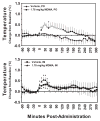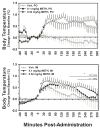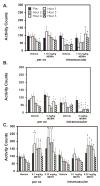Oral administration of (+/-)3,4-methylenedioxymethamphetamine and (+)methamphetamine alters temperature and activity in rhesus macaques
- PMID: 17475314
- PMCID: PMC1975960
- DOI: 10.1016/j.pbb.2007.03.015
Oral administration of (+/-)3,4-methylenedioxymethamphetamine and (+)methamphetamine alters temperature and activity in rhesus macaques
Abstract
Rationale: Emergency Department visits and fatalities in which (+/-)3,4-methylenedioxymethamphetamine (MDMA) or (+)methamphetamine (METH) are involved frequently feature unregulated hyperthermia. MDMA and METH significantly elevate body temperature in multiple laboratory species and, most importantly, can also produce unregulated and threatening hyperthermia in nonhuman primates. A majority of prior animal studies have administered drugs by injection whereas human consumption of "Ecstasy" is typically oral, an important difference in route of administration which may complicate the translation of animal data to the human condition.
Objective: To determine if MDMA and METH produce hyperthermia in monkeys following oral administration as they do when administered intramuscularly.
Methods: Adult male rhesus monkeys were challenged intramuscularly (i.m.) and per os (p.o.) with 1.78 or 5 mg/kg (+/-)MDMA and with 0.1 or 0.32 mg/kg (+)METH. Temperature and activity were monitored with a radiotelemetry system.
Results: Oral administration of either MDMA or METH produced significant increases in body temperature. Locomotor activity was suppressed by MDMA and increased by METH following either route of administration.
Conclusions: The data show that the oral route of administration is not likely to qualitatively reduce the temperature increase associated with MDMA or METH although oral administration did slow the rate of temperature increase. It is further established that MDMA reduces activity in monkeys even after relatively high doses and oral administration.
Figures





Similar articles
-
The role of monoamines in the changes in body temperature induced by 3,4-methylenedioxymethamphetamine (MDMA, ecstasy) and its derivatives.Br J Pharmacol. 2010 Jul;160(5):1029-44. doi: 10.1111/j.1476-5381.2010.00722.x. Br J Pharmacol. 2010. PMID: 20590597 Free PMC article. Review.
-
Effects of (+/-)3,4-methylenedioxymethamphetamine, (+/-)3,4-methylenedioxyamphetamine and methamphetamine on temperature and activity in rhesus macaques.Neuroscience. 2006 Oct 13;142(2):515-25. doi: 10.1016/j.neuroscience.2006.06.033. Epub 2006 Jul 28. Neuroscience. 2006. PMID: 16876329 Free PMC article.
-
Impact of ambient temperature on hyperthermia induced by (+/-)3,4-methylenedioxymethamphetamine in rhesus macaques.Neuropsychopharmacology. 2007 Mar;32(3):673-81. doi: 10.1038/sj.npp.1301078. Epub 2006 Apr 12. Neuropsychopharmacology. 2007. PMID: 16641942 Free PMC article.
-
MDMA ('Ecstasy') and methamphetamine combined: order of administration influences hyperthermic and long-term adverse effects in female rats.Neuropharmacology. 2005 Aug;49(2):195-207. doi: 10.1016/j.neuropharm.2005.03.002. Neuropharmacology. 2005. PMID: 15993443
-
Current preclinical studies on neuroinflammation and changes in blood-brain barrier integrity by MDMA and methamphetamine.Neuropharmacology. 2014 Dec;87:125-34. doi: 10.1016/j.neuropharm.2014.02.015. Epub 2014 Mar 2. Neuropharmacology. 2014. PMID: 24594477 Review.
Cited by
-
Behavioral effects and pharmacokinetics of (±)-3,4-methylenedioxymethamphetamine (MDMA, Ecstasy) after intragastric administration to baboons.J Pharmacol Exp Ther. 2013 Jun;345(3):342-53. doi: 10.1124/jpet.113.203729. Epub 2013 Mar 20. J Pharmacol Exp Ther. 2013. PMID: 23516331 Free PMC article.
-
Effects of α-pyrrolidino-phenone cathinone stimulants on locomotor behavior in female rats.Drug Alcohol Depend. 2021 Oct 1;227:108910. doi: 10.1016/j.drugalcdep.2021.108910. Epub 2021 Jul 21. Drug Alcohol Depend. 2021. PMID: 34332176 Free PMC article.
-
The Role of HSP90α in Methamphetamine/Hyperthermia-Induced Necroptosis in Rat Striatal Neurons.Front Pharmacol. 2021 Jul 19;12:716394. doi: 10.3389/fphar.2021.716394. eCollection 2021. Front Pharmacol. 2021. PMID: 34349659 Free PMC article.
-
Influences of activity wheel access on the body temperature response to MDMA and methamphetamine.Pharmacol Biochem Behav. 2011 Sep;99(3):295-300. doi: 10.1016/j.pbb.2011.05.006. Epub 2011 May 13. Pharmacol Biochem Behav. 2011. PMID: 21605589 Free PMC article.
-
The role of monoamines in the changes in body temperature induced by 3,4-methylenedioxymethamphetamine (MDMA, ecstasy) and its derivatives.Br J Pharmacol. 2010 Jul;160(5):1029-44. doi: 10.1111/j.1476-5381.2010.00722.x. Br J Pharmacol. 2010. PMID: 20590597 Free PMC article. Review.
References
-
- Baggott M, Heifets B, Jones RT, Mendelson J, Sferios E, Zehnder J. Chemical analysis of ecstasy pills. JAMA. 2000;284:2190. - PubMed
-
- Ball J, Garfield T, Morin C, Steele D. Emergency Department Trends From the Drug Abuse Warning Network, Final Estimates 1995–2002. DAWN Series D-24, DHHS Publication No. (SMA) 03–3780. Rockville, MD: Substance Abuse and Mental Health Services Administration, Office of Applied Studies; 2003.
-
- Ball J, Morin C, Cover E, Green J, Sonnefeld J, Steele D, Williams T, Mallonee E Drug Abuse Warning Network. Interim National Estimates of Drug-Related Emergency Department Visits. DAWN Series D-26, DHHS Publication No. (SMA) 04–3972. Rockville, MD: Substance Abuse and Mental Health Services Administration, Office of Applied Studies; 2003. 2004.
-
- Bishop C, Taylor JL, Kuhn DM, Eskow KL, Park JY, Walker PD. MDMA and fenfluramine reduce L-DOPA-induced dyskinesia via indirect 5-HT1A receptor stimulation. Eur J Neurosci. 2006;23:2669–2676. - PubMed
Publication types
MeSH terms
Substances
Grants and funding
LinkOut - more resources
Full Text Sources
Other Literature Sources
Medical

